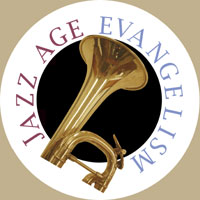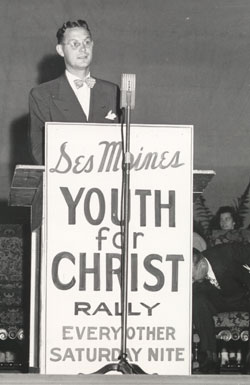

|
Epilogue
|
 |
| Torrey
Johnson speaking at a Youth for Christ rally in Des Moines, Iowa. Ca.
1946. Click on the image above to see an enlargment. |
Excerpt (2-3/4 minutes) from tape T1 in Collection 285, oral history interview with evangelist Torrey Johnson recorded by Bob Shuster on October 23, 1984.
JOHNSON: My father was a great admirer of Paul Rader. And I was also a great admirer, almost a...almost a disciple of Paul. So that while I went to my own church a great deal, getting into my later teens and early twenties, I took every opportunity I could to hear Paul Rader preach, both in the Tabernacle, which he had on North Avenue, which is now the Moody Church, and also when he moved to the Tabernacle on Barry and Halsted Streets. And I heard him many many times. I was greatly blessed and greatly challenged. In my way of thinking in my lifetime, Dr. Ironside was the great Bible teacher of Chicago in my lifetime and Paul Rader was by far the great evangelist of Chicago. And I was blessed by both those men.
SHUSTER: You said that you greatly admired him. What was it that you admired most about him?
JOHNSON: I think his world vision. He had a vision for the world and he had a heart that was big enough to take in a whole world. He was very daring. He was a great promoter. He had a great deal of imagination. He probably was a little bit ahead of his time. I think probably a part of his difficulty was he was too far ahead of the people and they couldn't quite either catch up or keep up with him. So that he pioneered a great deal of what other people did later on. And I think when you come to ask me about Youth For Christ, I think I would tell you this: I received my vision of the world from Paul Rader. And also from my pastor Dr. C.T. Dyrness and the missionary program he had. The difference between Rader and Dyrness was Dyrness was conventional, traditional, but with a burden for the world. Rader was more daring and imaginative and was a pioneer in taking missions out of the 19th century and putting it in the 20th century. So I received a good deal from both of them. But I think my fires were lit more in that regard from Paul Rader than from Dyrness. And I think that was one...that was one of my biggest contributions to Youth For Christ: world vision.
Leave the exhibit to read the entire transcript or thedescriptive guide of the Johnson collection